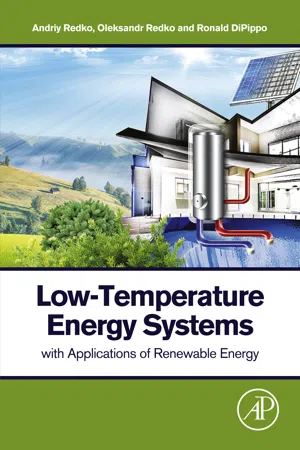
Low-Temperature Energy Systems with Applications of Renewable Energy
- 394 pages
- English
- ePUB (mobile friendly)
- Available on iOS & Android
Low-Temperature Energy Systems with Applications of Renewable Energy
About This Book
Low-Temperature Energy Systems with Applications of Renewable Energy investigates a wide variety of low-temperature energy applications in residential, commercial, institutional, and industrial areas. It addresses the basic principles that form the groundwork for more efficient energy conversion processes and includes detailed practical methods for carrying out these critical processes.
This work considers new directions in the engineering use of technical thermodynamics and energy, including more in-depth studies of the use of renewable sources, and includes worked numerical examples, review questions, and practice problems to allow readers to test their own comprehension of the material.
With detailed explanations, methods, models, and algorithms, Low-Temperature Energy Systems with Applications of Renewable Energy is a valuable reference for engineers and scientists in the field of renewable energy, as well as energy researchers and academics.
- Features end-of chapter review sections with questions and exercises for practical study and utilization.
- Presents methods for a great variety of energy applications to improve their energy operations.
- Applies real-world data to demonstrate the impact of low-temperature energy systems on renewable energy use today.
Frequently asked questions
Information
Principles and operation of refrigeration and heat pump systems
Abstract
Keywords
1.1. Trends in usage of low-temperature technologies
Table of contents
- Cover image
- Title page
- Table of Contents
- Copyright
- Dedication
- About the authors
- Preface
- Acknowledgments
- 1. Principles and operation of refrigeration and heat pump systems
- 2. Characteristics of low-temperature energy sources for heat pumps
- 3. Effective use of heat pumps for various heating applications
- 4. Heat pumps in the drying industry
- 5. Heating with geothermal systems
- 6. Geothermal energy in combined heat and power systems
- 7. Biofuels conversion: energy-saving processes and use of biogas
- 8. Hybrid systems with renewable energy sources
- 9. Industrial waste heat resources
- Index